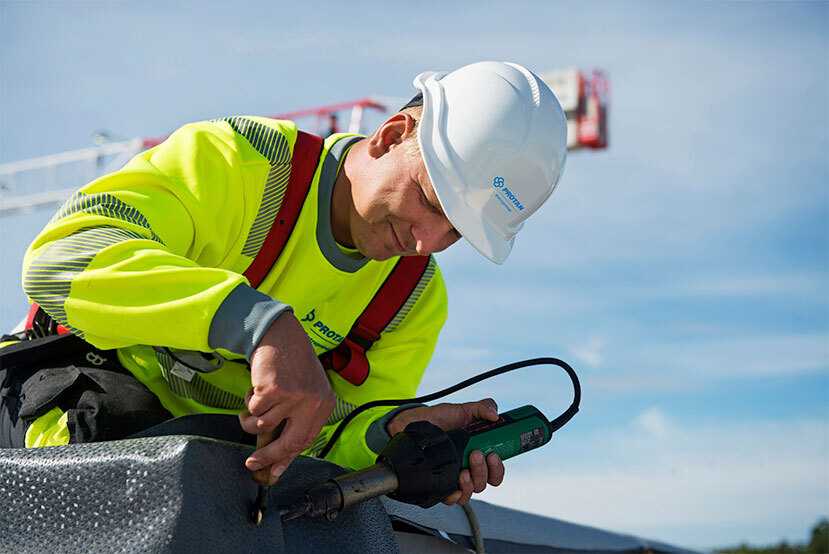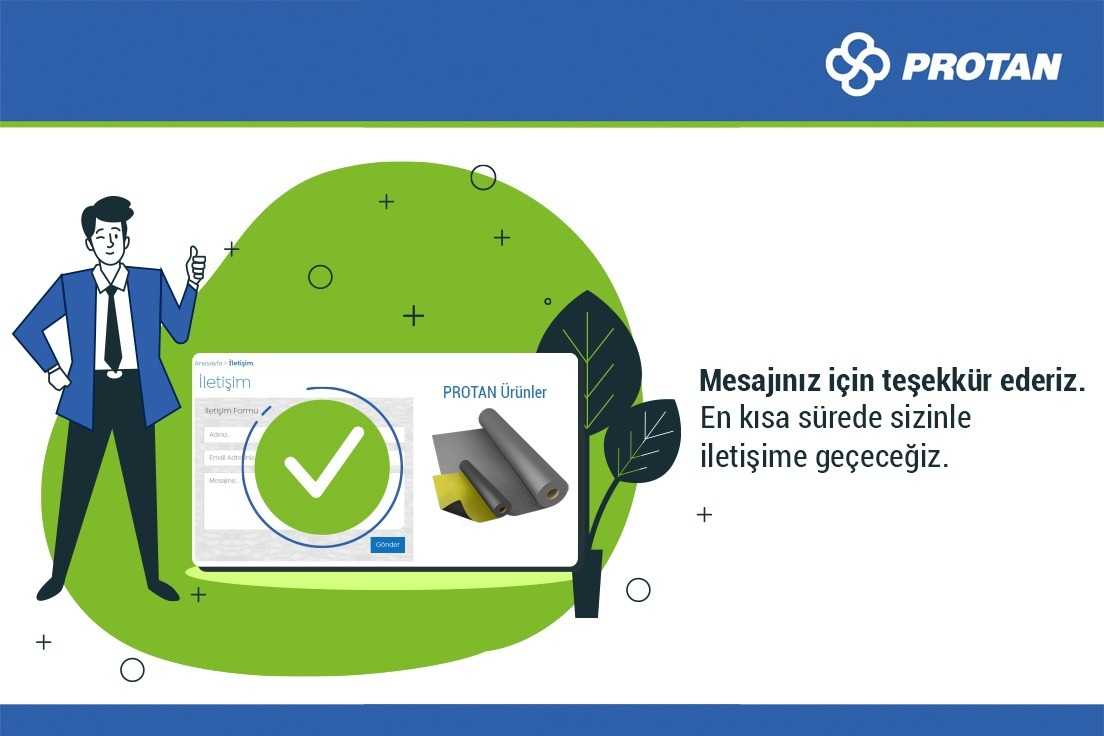What is PVC Membrane?
PVC (Poly Vinyl Chloride), a kind of polymer consisting of petroleum and salt, is produced in petrochemical plants. PVC membrane, which has many different application areas, is frequently used in the analysis of fine details in constructions. PVC waterproofing membranes, which are an ideal waterproofing material, can be applied from the foundation to the roof and all interlayers.
What Does PVC Membrane Do?
PVC membrane is used as a topcoat material to strengthen roof applications and increase their efficiency. In this way, the life of the roof can be extended and high efficiency can be obtained from the insulation. PVC membranes; It has high resistance to ozone, low temperatures and thermal aging. PVC membranes, which are mainly used for waterproofing buildings and roofs, are easy to install. They also have great tensile strength and long service life. PVC membrane, which does not require constant maintenance and repair, provides much better insulation compared to bituminous roofing materials.
Why is PVC Membrane Used?
PVC membrane material; Thanks to its chemical properties, it provides advanced insulation. Accordingly, it helps to prevent heat losses and save energy. The chlorine content allows the PVC membrane to extinguish in a short time in case of ignition. PVC membrane, which is much lighter and more useful than aluminum and wood, can be used easily when it is not desired to put a load on the buildings. The PVC membrane, which also provides sound insulation, has the feature of preventing noise pollution. PVC membrane, which can be used in almost all kinds of technical and construction areas, is among the environmentally friendly products due to its recycling feature. It also provides ease of use because it can be easily cleaned and does not require much maintenance. Due to all these features, PVC membrane, It can be used very comfortably on roofs and other parts of buildings. It is a great advantage to use PVC membrane as a finishing material, especially on surfaces that require insulation. PVC membrane, which is both an economical and easy to apply material, plays an important role in controlling the roofs and exterior surfaces of buildings.
What are the Differences of PVC Membrane?
After the PVC membrane insulation process is completed, the water is completely disconnected from the surface or the ground below. PVC membrane insulation is considered as a definitive isolation method to cut off the contact of water with the tank or to cut the water leakage to the tanks with intense water leakage and to prevent the contact of water with the tank. PVC is a frequently used thermoplastic elastomer due to its chemical and oil resistance and strong impact resistance properties and is considered to be extremely weather resistant.
Recently, there has been an increase in the use of single-layer membranes in the roofing industry due to their low-cost installation, long-term weatherability, and guaranteed protection against water. PVC membranes, which stand out among single-layer membranes thanks to their features, have the flexibility to best adapt to the technical and structural stresses that may arise in the structures, as well as the versatility to enable them to be used in various applications.
Where is PVC Membrane Used?
PVC membranes; It is also used in building foundations, dams, roofs, terraces, parking lots, treatment plants, pools, ponds for agricultural irrigation, drinking water tanks, underpasses, highway and railway tunnels, irrigation channels, subway stations and tunnels for waterproofing purposes. Protan SE PVC Covers; It is a PVC-based waterproofing membrane that is resistant to atmospheric conditions and sunlight. Polyester backing Protan SE PVC covers; Can be combined with hot air source. It is suitable for waterproofing on light metal roofs, concrete roofs, garden terrace roofs, dome or different shaped concrete or steel roofs. Protan EX PVC covers; It is resistant to sunlight and atmospheric conditions. Protan EX PVC covers with polyester carrier; They are PVC based water membranes produced for roof panels with polyester felt lamination. Especially in panel production; It is suitable for use on light metal roofs, stream and parapet insulation and renovation applications.
How to Use PVC Membrane?
Application of PVC membranes outside the temperatures suitable for the material in question can be risky in terms of both labor and welding safety. The team that will carry out the application must be experienced in the field and have sufficient technical equipment. Before the PVC membrane is applied, the application team visits the site and inspects the surfaces where the application will be made. If there are iron, pointed stones or similar protrusions on the surface that may cause the membranes to puncture or cut, these surfaces are corrected. Then, PVC membranes and Geotextiles are transported to the application area. PVC membranes are laid in such a way that the welding joints overlap each other by 8-10 cm. Welding is done by using electric robot welding devices. Welding in places that cannot be processed with a robot welding machine is performed with hand-held welding machines. The strength of the welds can be checked with 3 different methods. There is a test channel in the middle of the places where the robot welding device has welded. In the first method, the air test, the ends of the duct are closed with adjustable pliers and 2 bar air pressure is applied. Welding is considered successful if there is no pressure drop after the air pressure has been checked for about 5 minutes. The peel test is the second method, and 60-70 Kg/cm2 separation force is applied to the edge parts at the ends of the weld joints with pliers. If there is a separation as a result of this process, the weld joints are cut and the test is re-applied after welding again. In the vacuum test, which is the third and last method, the welding places made with hand-held welding devices are checked. Soap foam forming air bubbles is placed inside the vacuum device and vacuum is applied. When it is determined that there is no air leakage, the end points of the PVC membranes are locked with pressure strips. In addition, necessary precautions must be taken regarding the soundness and safety of the application areas. In addition to these, there are some points that need to be considered for the successful completion of the application. It is among the points that should be paid attention that the membrane insulations are attached to the building at the points where they reach the surface and that they are left at the base of the foundation in an appropriate proportion against settlements. Such as laying bricks vertically for protective purposes. Soap foam forming air bubbles is placed inside the vacuum device and vacuum is applied. When it is determined that there is no air leakage, the end points of the PVC membranes are locked with pressure strips. In addition, necessary precautions must be taken regarding the soundness and safety of the application areas. In addition to these, there are some points that need to be considered for the successful completion of the application. It is among the points that should be paid attention that the membrane insulations are attached to the building at the points where they reach the surface and that they are left at the base of the foundation in an appropriate proportion against settlements. Such as laying bricks vertically for protective purposes. Soap foam forming air bubbles is placed inside the vacuum device and vacuum is applied. When it is determined that there is no air leakage, the end points of the PVC membranes are locked with pressure strips. In addition, necessary precautions must be taken regarding the soundness and safety of the application areas. In addition to these, there are some points that need to be considered for the successful completion of the application. It is among the points that should be paid attention that the membrane insulations are attached to the building at the points where they reach the surface and that they are left at the base of the foundation in an appropriate proportion against settlements. Such as laying bricks vertically for protective purposes. When it is determined that there is no air leakage, the end points of the PVC membranes are locked with pressure strips.
It is not recommended to use these methods due to the risk that the mortars between the bricks may damage the insulation.


